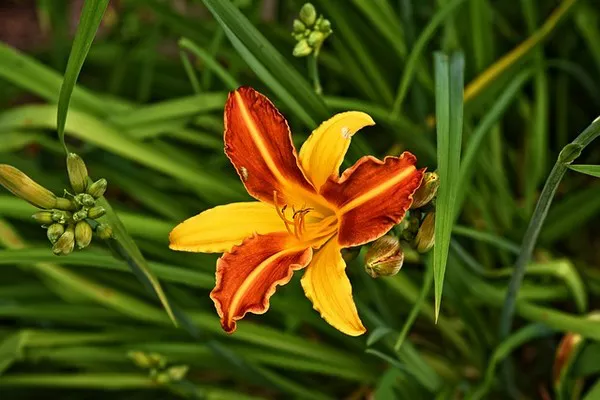Daylilies, scientifically known as Hemerocallis, are renowned for their vibrant blooms, resilience, and ease of care, making them beloved by gardeners worldwide. Among the myriad questions that enthusiasts ponder, one of the most common is, “How long do daylily plants live?” Understanding the lifespan of daylilies is crucial for garden planning, maintenance, and overall enjoyment of these beautiful perennials. In this comprehensive guide, we delve into the factors influencing the lifespan of daylily plants, maintenance practices to extend their longevity, and tips for ensuring optimal growth and blooming.
Introduction to Daylilies
Before delving into their lifespan, it’s essential to grasp the basics of daylilies. Originating from Asia, specifically China and Japan, daylilies have become ubiquitous in gardens across the globe. Their name, Hemerocallis, is derived from two Greek words, “hemera” meaning “day” and “kallos” meaning “beauty,” alluding to their ephemeral yet stunning blooms that typically last only one day. However, each daylily stem produces multiple buds, resulting in a profusion of flowers throughout the blooming season.
Daylilies are categorized into two main types based on their blooming habits: evergreen and dormant. Evergreen daylilies retain their foliage year-round, providing greenery even in winter months, while dormant daylilies shed their foliage in autumn, entering a period of dormancy until the following spring. Both types offer unique characteristics and adaptability to various climates, making them versatile additions to gardens.
Factors Influencing Daylily Lifespan
Several factors influence the lifespan of daylily plants, ranging from environmental conditions to cultural practices. Understanding these variables can help gardeners optimize conditions to prolong the longevity of their daylilies.
1. Climate and Growing Conditions: Daylilies are remarkably adaptable and can thrive in a wide range of climates, from temperate to subtropical regions. However, they prefer well-drained soil and ample sunlight for optimal growth and blooming. In colder climates, selecting cold-hardy cultivars and providing winter protection can enhance their survival rate.
2. Cultivar Selection: The choice of daylily cultivars significantly impacts their lifespan. Some cultivars are bred for longevity, disease resistance, and overall vigor, while others may be more susceptible to pests or environmental stressors. Researching and selecting reputable cultivars known for longevity can yield more durable and resilient plants.
3. Soil Quality and Nutrition: Nutrient-rich soil is essential for sustaining healthy daylilies over the long term. Amending soil with organic matter, such as compost or aged manure, improves soil structure, fertility, and moisture retention, promoting robust root development and prolonged lifespan. Regular fertilization with balanced formulations further supports growth and flowering.
4. Watering Practices: Adequate moisture is critical for daylilies, especially during their active growth and blooming periods. Consistent watering, ensuring the soil remains evenly moist but not waterlogged, promotes healthy foliage and flowering. Drought stress can weaken plants and shorten their lifespan, so monitoring soil moisture levels is crucial, particularly in hot, dry climates.
5. Pest and Disease Management: Vigilant pest and disease management are essential for preserving daylilies’ health and longevity. Common pests such as aphids, thrips, and spider mites can damage foliage and flowers if left unchecked. Likewise, fungal diseases like rust and leaf spot can weaken plants over time. Implementing integrated pest management strategies, including regular inspections, cultural practices, and, if necessary, targeted pesticide applications, helps mitigate these risks.
6. Division and Propagation: Daylilies benefit from periodic division to rejuvenate overcrowded clumps and maintain vigor. Dividing plants every few years not only prevents overcrowding but also stimulates new growth and flowering. Additionally, propagating daylilies through division or seed ensures a renewable supply of plants, prolonging their presence in the garden.
7. Mulching and Weed Control: Applying a layer of organic mulch around daylilies helps conserve soil moisture, suppress weeds, and regulate soil temperature—all of which contribute to healthier plants and extended lifespan. Mulching also protects daylily crowns from temperature extremes and reduces the risk of mechanical damage from mowing or trimming.
Tips for Prolonging Daylily Lifespan
Based on the aforementioned factors, several practical tips can help gardeners extend the lifespan of their daylily plants:
1. Choose Suitable Cultivars: Select daylily cultivars known for longevity, disease resistance, and adaptability to your local climate and growing conditions.
2. Provide Adequate Care: Maintain optimal soil moisture, fertility, and drainage to support healthy growth and flowering. Regularly inspect plants for pests and diseases, addressing issues promptly to prevent escalation.
3. Implement Division and Propagation: Divide overcrowded clumps every few years to rejuvenate plants and promote vigor. Consider propagating daylilies through division or seed to expand your garden collection.
4. Mulch and Weed: Apply mulch to conserve soil moisture, suppress weeds, and protect daylily crowns. Keep the area around daylilies free of weeds and debris to minimize competition and reduce pest habitats.
5. Monitor Environmental Conditions: Be mindful of temperature fluctuations, especially in regions with extreme weather. Provide winter protection for daylilies in colder climates to minimize frost damage.
6. Practice Integrated Pest Management: Regularly inspect daylilies for signs of pests and diseases, employing cultural and biological controls as needed. Minimize chemical interventions to avoid potential harm to beneficial insects and the environment.
7. Stay Vigilant: Continuously monitor the health and performance of daylilies, adjusting care practices as necessary to optimize conditions and prolong lifespan.
By incorporating these strategies into their gardening routine, enthusiasts can enjoy vibrant daylily displays year after year, enhancing the beauty and longevity of their outdoor spaces.
Conclusion
The lifespan of daylily plants is influenced by various factors, including climate, cultivar selection, cultural practices, and pest management. By understanding these dynamics and implementing proactive care strategies, gardeners can extend the lifespan of their daylilies, ensuring years of beauty and enjoyment in the garden. Whether you’re a seasoned enthusiast or a novice gardener, cultivating healthy and long-lived daylilies is achievable with dedication, attention to detail, and a deep appreciation for nature’s splendor.


